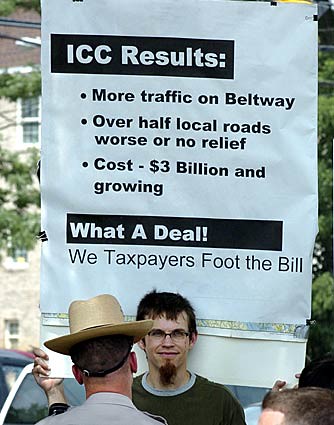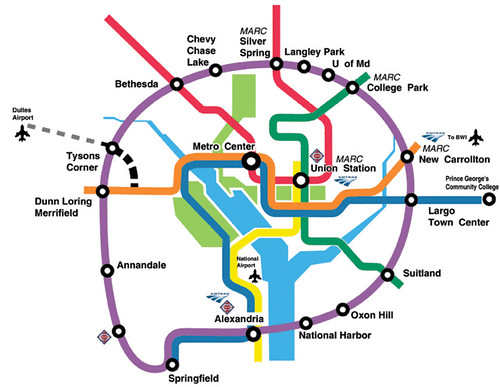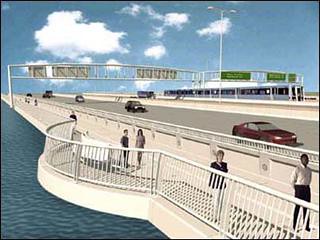National Harbor in Prince George's County and the Inter County Connector in Montgomery and PG Counties: belated critical analysis in the Post
I've noticed that it takes years for the Post to get around to writing critical analysis of big infrastructure projects, as opposed to taking a more cheerleading perspective early on.

Chris Carney, a member of the Sierra Club, protests the proposed route for the Inter-County Connector. (Baltimore Sun photo by Elizabeth Malby). Jul 11, 2005.
I've written about this before with regard to the Inter County Connector, a highway connecting the I-270 corridor in Montgomery County with the I-95 corridor in Prince George's County. Maybe such a road is needed--and it will save people traveling that way a lot of time--but the development comes at the cost of encumbering any significant roadway infrastructure development in the State of Maryland for the next 20 years.
Earlier in the week, on the eve of most of the route being opened for operation, the Post ran an article about the economic negatives resulting from the ICC, "ICC puts strain on Maryland’s transportation funds." From the article:
The 18.8-mile Intercounty Connector, which opened in full Tuesday, could be the last publicly funded highway built in Maryland for a generation, as the state’s tolling agency, which financed its $2.56 billion construction, reaches its debt limit, local transportation experts said.
Financing for the six-lane toll road linking Interstate 270 in Montgomery County with Interstate 95 in Prince George’s County leveraged the Maryland Transportation Authority’s statewide toll collections.
But the transportation authority’s debt capacity is tapped out from borrowing to build the ICC and $1 billion in express toll lanes on I-95 northeast of Baltimore, state budget analysts said. Mounting debt recently prompted the authority to raise tolls statewide as the authority also struggles to maintain its aging bridges, tunnels and roads.
“You’re probably looking at another 20 years before we see another major road like this be built,” said Lon Anderson, a spokesman for AAA Mid-Atlantic.
While I am not a fan of building new roads necessarily, limiting the ability to do so for 20-30 years, in favor of constructing 19 miles of road in one place in the entire state doesn't seem to be a sound tradeoff.
Today there is an article about National Harbor, a big development in Prince George's County, a project positioned next to Beltway, disconnected from high capacity transit, and marketed as DC but not in DC, "Disney backs out of National Harbor" about how Disney is no longer going to build a resort there.
But the article has what feels to me to be the first printed critical analysis in the paper about the project, stuff I (and others) have written about for years. From the article:
The loss hits home just as the development, majority-owned by the Peterson Cos., was recovering some positive buzz. It got off to a slow start in 2008, running immediately into a severe economic downturn.
“We are disappointed,” Jon Peterson, senior vice president of the Peterson Cos., said Friday. But he added that “there was always a little bit of uncertainty” over whether Disney would follow through after the company bought the land.
Prince George’s and the Peterson Cos. had ballyhooed Disney’s May 2009 purchase of 11 acres for $11 million as a validation of their vision for the 300-acre site. ...
But the harbor has had mixed success in persuading national retailers to open stores there and has faced some head winds in encouraging families to buy condominium units there. It is not readily accessible by Metro or by car from Northern Virginia and parts of Maryland. With only one-third of the development completed, about $2.2 billion has been spent.
Little previous coverage raised these issues, and the Post never editorializes in favor of linking transportation investments and transit expansion to big land development projects like National Harbor.
Critical analysis articles and editorials about the best course of action in the early stage of projects would have far more positive impact and greater likelihood of improving and correcting gaps and potential failures within the projects long before they are built.
Writing these kinds of articles years later, like the lawsuit in Brookland over undergrounding utilities after the streetscape has already been constructed, is hot air.
It's no wonder why the process of organizational improvement and process innovation in the region is soooooooooooooooooooooooooooooooooooooooooooooooooooooooooooo slow, because we don't look at ourselves and how we do things, and there are limited outlets for critical analysis, and limited ways for the thinking public and advocates to shape the process, especially because we can expect very little press coverage of our positions, until it is too late to have any substantive positive impact.
Labels: civic engagement, Growth Machine, media and communications, real estate development, transportation planning, urban design/placemaking, urban revitalization





0 Comments:
Post a Comment
<< Home